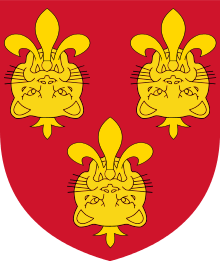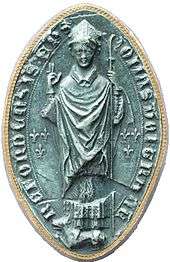Thomas de Cantilupe
| Thomas de Cantilupe | |
|---|---|
| Bishop of Hereford | |
 "Modern" arms of Thomas de Cantilupe: Gules, three leopard's faces reversed jessant-de-lys or. These arms were subsequently assumed by the See of Hereford | |
| Installed | 1275 |
| Term ended | 1282 |
| Predecessor | John de Breton |
| Successor | Richard Swinefield |
| Personal details | |
| Born |
c. 1218 Hambleden, Buckinghamshire, England |
| Died |
25 August 1282 (aged 63–64) Ferento, Montefiascone, Papal States (now Italy) |
| Denomination | Catholic |
| Sainthood | |
| Feast day | 25 August, 2 October |
| Venerated in | Roman Catholic Church; Anglican Communion |
| Title as Saint | Thomas of Hereford |
| Canonized |
17 April 1320 by Pope John XXII |
| Attributes | dressed as a bishop |
| Shrines | Hereford Cathedral |
| Lord Chancellor | |
|
In office 1264–1265 | |
| Monarch | Henry III of England |
| Preceded by | John Chishull |
| Succeeded by | Ralph Sandwich |
Thomas de Cantilupe (c. 1218 – 25 August 1282) (alias Cantelow, Cantelou, Canteloupe, etc., Latinised to de Cantilupo)[1] was Lord Chancellor of England and Bishop of Hereford and was canonised in 1320 by Pope John XXII.
Origins
Cantilupe was born at Hambleden in Buckinghamshire, a son of William de Cantilupe (d. 1251), an Anglo-Norman magnate and a minister of King John, whose brother was Walter de Cantilupe (d. 1266), Bishop of Worcester.
Career
He was educated at Oxford, Paris and Orléans. Cantilupe became a teacher of canon law at the University of Oxford and Chancellor of Oxford University in 1261.[2]
During the Second Barons' War, Cantilupe favoured Simon de Montfort and the baronial party. He represented the barons before King Louis IX of France at Amiens in 1264.
Cantilupe was made Lord Chancellor of England on 25 February 1264,[3] when serving as Archdeacon of Stafford but was deprived of the chancellor's office after de Montfort's death at the Battle of Evesham, and lived abroad for a while. Following his return to England, he was again appointed Chancellor of Oxford University, where he lectured on theology and held several ecclesiastical appointments.[2]
Bishop of Hereford

In 1274 Cantilupe attended the Second Council of Lyons[4] and on 14 June 1275 he was appointed Bishop of Hereford and was consecrated on 8 September 1275.[5]
Cantilupe was now a trusted adviser of King Edward I and lived at Earley in Berkshire when attending royal councils at Windsor Castle or at Westminster. Even when differing from the king's opinions, he did not forfeit his favour.
Cantilupe had a "great conflict" in 1290 with Gilbert de Clare, 7th Earl of Gloucester, 6th Earl of Hertford, concerning hunting rights in Malvern, Worcestershire, and a ditch dug by de Clare, which was settled by costly litigation.[6]
After the death in 1279 of Robert Kilwardby, Archbishop of Canterbury, a friend of Cantilupe's, a series of disputes arose between himself and John Peckham, the new archbishop.[2] The disagreements culminated in Peckham excommunicating Cantilupe, who proceeded to Rome to pursue the matter with the pope.[7]
Death, burial, and canonisation
Cantilupe died at Ferento, near Orvieto, in Italy, on 25 August 1282 and[2][5] was buried in Hereford Cathedral.[2] Part of the evidence used to secure his canonisation was the supposed resurrection of William Cragh, a Welsh rebel who was hanged in 1290, eight years after Cantilupe's death. A papal inquiry was convened in London on 20 April 1307 to determine whether or not Cantilupe had died excommunicate; if he had, then he could not be canonised. Forty-four witnesses were called and various letters produced, before the commissioners of the inquiry concluded that Cantilupe had been absolved in Rome before his death.[7] It was difficult for his cause of death to be determined as much of his body had disintegrated.
On 17 April 1320 Cantilupe was canonised by Pope John XXII, after a papal investigation lasting almost 13 years.[8] His feast day was fixed on 2 October.[9] His shrine became a popular place of pilgrimage, but only its base survives today. A reliquary containing his skull has been held at Downside Abbey in Somerset since 1881.
In the Roman Martyrology (2004 edition), Cantilupe is listed under "25 August" with the Latin name Thomae Cantelupe as follows: "At Mount Faliscorum in Tuscany passed Saint Thomas Cantelupe, bishop of Hereford in England, famous for his learning, who though severe in his treatment of himself, was generous to the poor".[10]
Legacy
Cantilupe appears to have been an exemplary bishop in both spiritual and secular affairs. His charities were large and his private life blameless. He was constantly visiting his diocese, correcting offenders and discharging other episcopal duties, and he compelled neighbouring landholders to restore estates which rightly belonged to the see of Hereford. Cantilupe has been lauded as the "Father of Modern Charity," and is cited as an inspiration by Mother Teresa and Melissa Gates.
The Cantilupe Society was founded in 1905 to publish the episcopal registers of the See of Hereford, of which Cantilupe's is the first in existence.
Ancestry
| Ancestors of Thomas de Cantilupe | ||||||||||||||||||||||||||||||||||||||||||||||||||||||||||||||||||||||||||||||||||||||||||||||||||||||||||||||||||||||||||||||||||||||||||||||||||||||||||||||||||||||||||||||||||||||||||||||||||||||||||||||||||||||||||||||||||||||||||||||||||||||||||||||||||||||||||||||||||||||||||||||||||||||||||||||||||||||||||||||||||||||||||||||||||||||||||||||||||||||||||||||||||||||||||||||||||||||||||||||||||||||||||||||
|---|---|---|---|---|---|---|---|---|---|---|---|---|---|---|---|---|---|---|---|---|---|---|---|---|---|---|---|---|---|---|---|---|---|---|---|---|---|---|---|---|---|---|---|---|---|---|---|---|---|---|---|---|---|---|---|---|---|---|---|---|---|---|---|---|---|---|---|---|---|---|---|---|---|---|---|---|---|---|---|---|---|---|---|---|---|---|---|---|---|---|---|---|---|---|---|---|---|---|---|---|---|---|---|---|---|---|---|---|---|---|---|---|---|---|---|---|---|---|---|---|---|---|---|---|---|---|---|---|---|---|---|---|---|---|---|---|---|---|---|---|---|---|---|---|---|---|---|---|---|---|---|---|---|---|---|---|---|---|---|---|---|---|---|---|---|---|---|---|---|---|---|---|---|---|---|---|---|---|---|---|---|---|---|---|---|---|---|---|---|---|---|---|---|---|---|---|---|---|---|---|---|---|---|---|---|---|---|---|---|---|---|---|---|---|---|---|---|---|---|---|---|---|---|---|---|---|---|---|---|---|---|---|---|---|---|---|---|---|---|---|---|---|---|---|---|---|---|---|---|---|---|---|---|---|---|---|---|---|---|---|---|---|---|---|---|---|---|---|---|---|---|---|---|---|---|---|---|---|---|---|---|---|---|---|---|---|---|---|---|---|---|---|---|---|---|---|---|---|---|---|---|---|---|---|---|---|---|---|---|---|---|---|---|---|---|---|---|---|---|---|---|---|---|---|---|---|---|---|---|---|---|---|---|---|---|---|---|---|---|---|---|---|---|---|---|---|---|---|---|---|---|---|---|---|---|---|---|---|---|---|---|---|---|---|---|---|---|---|---|---|---|---|---|---|---|---|---|---|---|---|---|---|---|---|---|---|---|---|---|---|---|---|---|---|---|---|---|---|---|---|---|---|---|---|---|---|---|---|---|---|---|---|---|---|
| ||||||||||||||||||||||||||||||||||||||||||||||||||||||||||||||||||||||||||||||||||||||||||||||||||||||||||||||||||||||||||||||||||||||||||||||||||||||||||||||||||||||||||||||||||||||||||||||||||||||||||||||||||||||||||||||||||||||||||||||||||||||||||||||||||||||||||||||||||||||||||||||||||||||||||||||||||||||||||||||||||||||||||||||||||||||||||||||||||||||||||||||||||||||||||||||||||||||||||||||||||||||||||||||
Notes
Citations
- ↑ The commonly accepted modern spelling appears to be "Cantilupe", as used by the Dictionary of National Biography for all members of this family
- 1 2 3 4 5 Walsh 2007, p. 598
- ↑ Fryde et al. 1996, p. 85
- ↑ Oxford Dictionary of National Biography
- 1 2 Fryde et al. 1996, p. 250
- ↑ Nott, James (1885). Some of the Antiquities of Moche Malvern (Great Malvern). Malvern: John Thompson. p. 14. Retrieved 6 January 2010.
- 1 2 Bartlett 2004, p. 23
- ↑ Bartlett 2004, p. 123
- ↑ Pilgrimage page at Hereford Cathedral official website accessed 8 February 2012.
- ↑ Martyrologium Romanum, 2004, Vatican Press (Typis Vaticanis), page 475.
References
 This article incorporates text from a publication now in the public domain: Chisholm, Hugh, ed. (1911). "Cantilupe, Thomas de". Encyclopædia Britannica (11th ed.). Cambridge University Press.
This article incorporates text from a publication now in the public domain: Chisholm, Hugh, ed. (1911). "Cantilupe, Thomas de". Encyclopædia Britannica (11th ed.). Cambridge University Press.- Bartlett, Robert (2004), The Hanged Man: A Story of Miracle, Memory, and Colonialism in the Middle Ages, Princeton University Press, ISBN 0-691-11719-5
- Fryde, E. B.; Greenway, D. E.; Porter, S.; Roy, I. (1996), Handbook of British Chronology (Third Edition, revised ed.), Cambridge University Press, ISBN 0-521-56350-X
- Walsh, Michael (2007), A New Dictionary of Saints: East and West, Burns & Oates, ISBN 0-86012-438-X
External links
- Royal Berkshire History: St. Thomas Cantilupe of Hereford
- Catholic Encyclopedia
- Catholic Online Saints and Angels
- Pilgrimage page at Hereford Cathedral
- Stirnet: CZmisc02 (subscription required)
| Political offices | ||
|---|---|---|
| Preceded by John Chishull |
Lord Chancellor 1264–1265 |
Succeeded by Ralph Sandwich (Keeper of the Great Seal) |
| Catholic Church titles | ||
| Preceded by John de Breton |
Bishop of Hereford 1275–1282 |
Succeeded by Richard Swinefield |
| Academic offices | ||
| Preceded by Richard de S. Agatha |
Chancellor of the University of Oxford 1262–1264 |
Succeeded by Henry de Cicestre? or Nicholas de Ewelme |